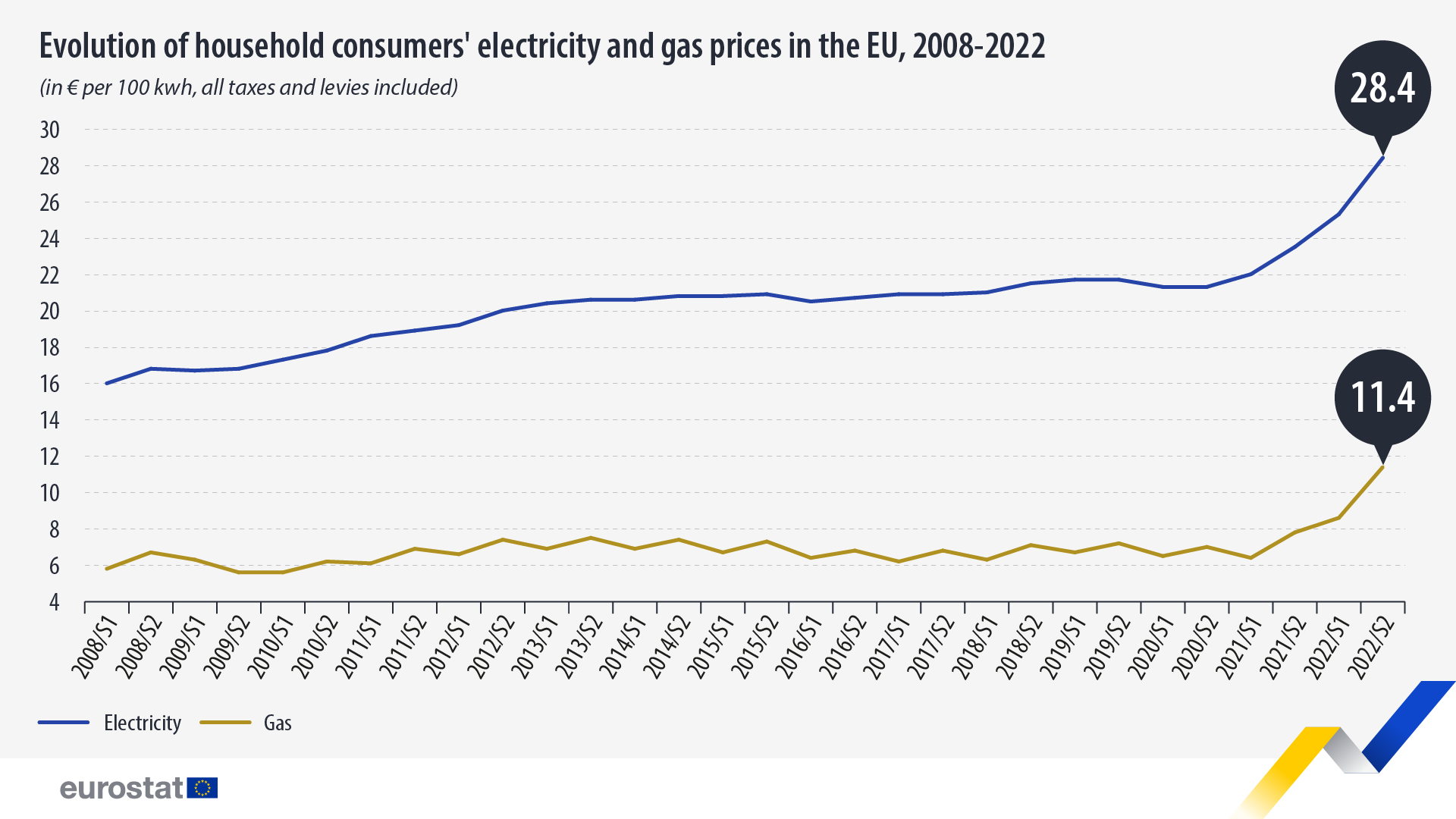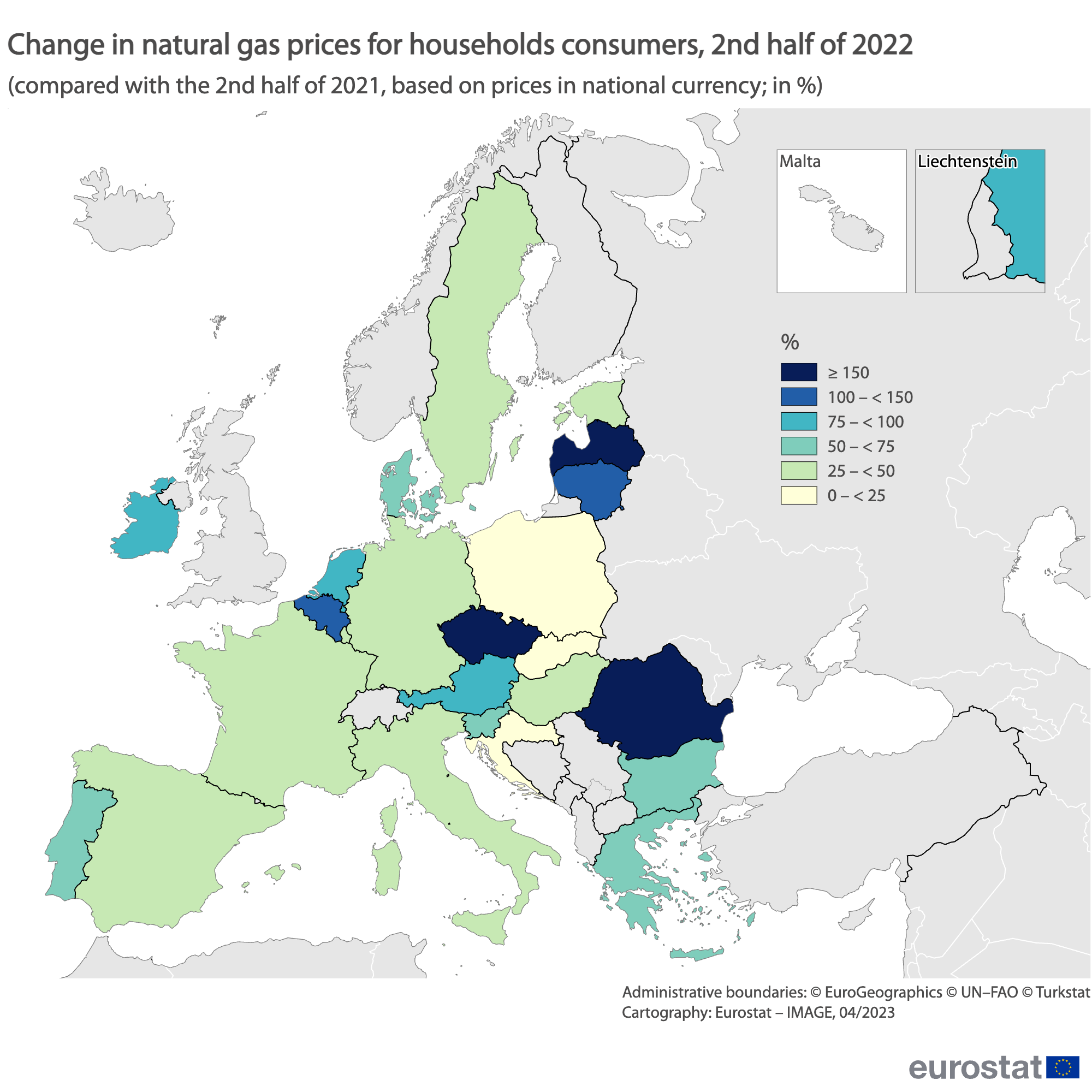In the second half of 2022, average household electricity prices in the EU continued to show a sharp increase compared with the same period in 2021, from €23.5 per 100 kWh to €28.4 per 100 kWh. Average gas prices also increased compared with the same period in 2021 from €7.8 per 100 kWh to €11.4 per 100 kWh in the second half of 2022. These prices are the highest on Eurostat’s record.
After a significant increase in prices that started before the Russian invasion of Ukraine but skyrocketed up to the second semester of 2022, electricity and natural gas prices have recently shown signs of stabilizing, partly due to policies and interventions by EU governments. EU countries opted for various measures, such as reducing taxes and fees, temporary tax waivers to consumers, price caps, providing lump sum support or allocating vouchers to final consumers, and some countries applied regulated prices.
Compared with the second half of 2021, the share of taxes in the electricity bill dropped sharply from 36% to 16% (-18.3%) and in the gas bill from 27% to 14% (-15.8%), with all EU countries putting in place governmental allowances and subsidies or reduce taxes and levies to mitigate high-energy costs. These governmental measures, while lowering energy prices for the final consumer, have burdened governmental accounts.
This information comes from data on electricity and gas prices published recently by Eurostat. The article presents a handful of findings from the more detailed Statistics Explained articles on electricity prices and natural gas prices.
Electricity prices up in all EU countries except Malta and the Netherlands
Household electricity prices rose in all EU members, except Malta (-3%, in national currencies) and the Netherlands (-7%), in the second half of 2022, compared with the same period of 2021. Prices in Malta are regulated, while the Dutch government supports consumers with lump sums and taxes reduction. The highest increases were recorded in Romania (+112%), Czechia (+97%), Denmark (+70%), Lithuania (+65%) and Latvia (+59%), while the lowest were in Luxembourg (+3%), Austria and Germany (both +4%), and Poland and Bulgaria (both +5%).  Expressed in euro, average household electricity prices in the second half of 2022 were lowest in Hungary (€10.8 per 100 kWh), Bulgaria (€11.5) and Malta (€12.8) and highest in Denmark (€58.7), Belgium (€44.9), and Ireland (€42.0).
Expressed in euro, average household electricity prices in the second half of 2022 were lowest in Hungary (€10.8 per 100 kWh), Bulgaria (€11.5) and Malta (€12.8) and highest in Denmark (€58.7), Belgium (€44.9), and Ireland (€42.0).
Gas prices increased in all EU countries
Between the second half of 2021 and the second half of 2022, gas prices increased in all 27 EU countries. Gas prices (in national currencies) surged the most in Czechia (+231%), Romania (+165%), Latvia (+157%), Lithuania (+112%) and Belgium (+102%). There were only two increases below 20%: Croatia (+14%) and Slovakia (18%). All price increases are from the energy and supply component, mainly driven by the recent energy crisis.
Expressed in euro, average household gas prices in the second half of 2022 were lowest in Hungary (€3.5 per 100 kWh), Croatia (€4.5) and Slovakia (€4.9) and highest in Sweden (€27.5), Denmark (€20.8) and the Netherlands (€19.3). The price of natural gas for households in Sweden was 157 % higher than the EU average price. However, natural gas use in Sweden is very limited.
Source: Eurostat
Legal Notice: The information in this article is intended for information purposes only. It is not intended for professional information purposes specific to a person or an institution. Every institution has different requirements because of its own circumstances even though they bear a resemblance to each other. Consequently, it is your interest to consult on an expert before taking a decision based on information stated in this article and putting into practice. Neither MuhasebeNews nor related person or institutions are not responsible for any damages or losses that might occur in consequence of the use of the information in this article by private or formal, real or legal person and institutions.




























